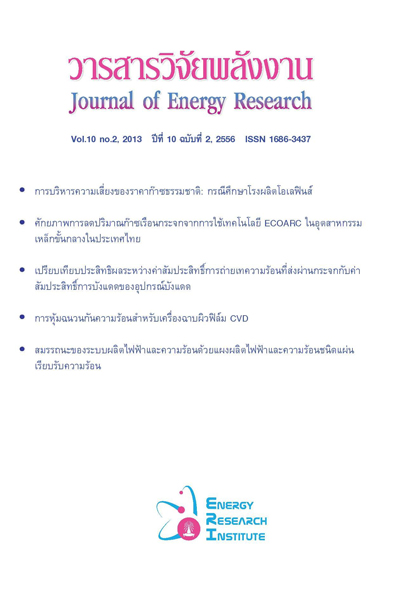เปรียบเทียบประสิทธิผลระหว่างค่าสัมประสิทธิ์การถ่ายเทความร้อนที่ส่งผ่านกระจกกับค่าสัมประสิทธิ์การบังแดดของอุปกรณ์บังแดด
Main Article Content
Abstract
งานวิจัยนี้เป็นการวิจัยเชิงทดลอง (experimental research) เพื่อศึกษาเปรียบเทียบการออกแบบวัสดุประกอบช่องเปิดอาคารเพื่อลดการถ่ายเทความร้อนผ่านช่องเปิดอาคาร ระหว่างการใช้ค่าสัมประสิทธิ์การถ่ายเทความร้อนจากรังสีอาทิตย์ที่ส่งผ่านกระจก (Solar Heat Gain Coefficient , SHGC) กับการใช้ค่าสัมประสิทธิ์การบังแดดของอุปกรณ์บังแดด (Shading Coefficient , SC) โดยการศึกษาจะใช้วิธีการทดลองจริงกับอาคารทดลองด้านพลังงาน (mockup energy testing) ขนาด 3.00 x 3.00 ตารางเมตร สองอาคารเพื่อเปรียบเทียบผลการทดลอง โดยอาคารแรกใช้ค่าสัมประสิทธิ์การถ่ายเทความร้อนจากรังสีอาทิตย์ที่ส่งผ่านกระจก (SHGC) ในการลดความร้อนผ่านช่องเปิดอาคาร ส่วนอาคารที่สองใช้ค่าสัมประสิทธิ์การบังแดดของอุปกรณ์บังแดด (SC) ในการลดความร้อนผ่านช่องเปิดอาคาร การทดลองใช้เครื่องมือทางวิทยาศาสตร์ในการบันทึกข้อมูลและวัดอัตราการใช้พลังงานปรับอากาศที่เกิดขึ้นจริงในสภาพภูมิอากาศของประเทศไทย การทดลองมีทั้งหมดสามการทดลอง โดยในแต่ละการทดลองได้ควบคุมให้ค่าสัมประสิทธิ์การถ่ายเทความร้อนจากรังสีอาทิตย์ที่ส่งผ่านกระจก (SHGC) ของอาคารทดลองหลังแรกเท่ากับค่าสัมประสิทธิ์การบังแดด (SC) ของอุปกรณ์บังแดดของอาคารหลังที่สอง ในสามการทดลองกำหนดให้ค่าสัมประสิทธิ์การถ่ายเทความร้อนจากรังสีอาทิตย์ที่ส่งผ่านกระจก (SHGC) และ ค่าสัมประสิทธิ์การบังแดดของอุปกรณ์บังแดด (SC) มีค่าสูงปานกลาง และ ต่ำ
ผลการทดลองพบว่าประสิทธิผลการประหยัดพลังงานปรับอากาศของอาคารที่ใช้ค่าสัมประสิทธิ์การถ่ายเทความร้อนจากรังสีอาทิตย์ที่ส่งผ่านกระจก (SHGC) ดีกว่าอาคารที่ใช้ค่าสัมประสิทธิ์การบังแดดของอุปกรณ์บังแดด (SC) ในทุกการทดลอง แนวโน้มสัดส่วนการประหยัดพลังงานปรับอากาศจากการใช้ค่าสัมประสิทธิ์ทั้งสองมากขึ้นเรื่อยๆ เมื่อค่าสัมประสิทธิ์ดังกล่าวมีค่าต่ำลง กล่าวคือค่าความแตกต่างของการประหยัดพลังงานจะมากขึ้นเมื่อเลือกใช้กระจกคุณภาพดีและอุปกรณ์บังแดดที่มีค่าสัมประสิทธิ์การบังแดดดีขึ้น ในขณะที่สภาวะสบายเชิงอุณหภาพ (thermal comfort) ในอาคารที่ใช้ค่าสัมประสิทธิ์การถ่ายเทความร้อนจากรังสีอาทิตย์ที่ส่งผ่านกระจก (SHGC) ดีกว่าในทุกการทดลอง แต่อาคารที่ใช้ค่าสัมประสิทธิ์การบังแดดของอุปกรณ์บังแดด (SC) ในการป้องกันความร้อนเข้าสู่อาคาร จะนำแสงธรรมชาติเข้ามาในตัวอาคารได้ดีกว่าอย่างสังเกตได้
THE COMPARISON OF EFFECTIVE SHADING COEFFICIENT BETWEEN GLAZING GLASS AND SHADING DEVICE
Jiradet Theppipit and Thanit Jindavanig
Faculty of Architecture, Chulalongkorn University
The aim of this research is to compare the effectiveness of materials used in apertures to reduce the transmission on solar heat. The materials compared were glass and a shading device. The research involved experiments to find the shading coefficient of glazing glass (SHGC) and that of a shading device (SC) which are used in the equation of total heat gain in a wall panel (OTTV) to meet the standard and methods of energy conservation in regulated buildings. The experiment was undertaken in mockup energy test using 3.00 x 3.00 meters panels to measure the rate of energy consumption under real conditions of the Thai climate. These experiments were coupled with computer simulations to find the effect of aperture direction of the rate of energy use in air-conditioned buildings. We under took three case studies undertaken by specifying different coefficients of solar heat gain of glazing glass (SHGC) and that of the shading device (SC), followed by analyzing the results of the two case studies in order to obtain the research results.
From the studies, we found that energy conservation in air-conditioned buildings was more effective if glass were used instead of a shading device as measured by the coefficient of solar heat gain. Moreover, if the quality of the glass and that of the shading device were improved, the gap between the two coefficients only increased so that glass further outperformed the shading device. If the effect on human comfort were also determined, the glass outperformed the shading device on this measure also. However, the shading device was more effective with respect to one criterion—that of bringing natural light into a building.

